Age Two: Danielle in Wonderland
4. The Caterpillar
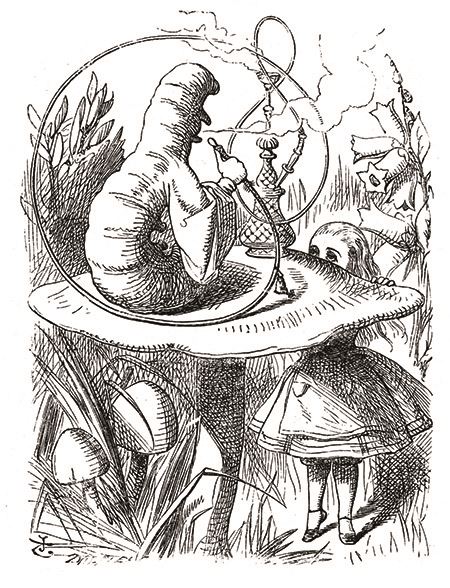
John Tenniel’s 1865 illustration of the Caterpillar from the original book Alice’s Adventures in Wonderland. Note the ambiguous image of what looks like a human head made up of the legs of a caterpillar.
Discussions Alice has with the Caterpillar in Alice’s Adventures in Wonderland are typical of the circular and illogical logic that characterizes Wonderland. For example, consider this dialogue:
| “Who are you?” said the Caterpillar.
This was not an encouraging opening for a conversation. Alice replied, rather shyly, “I—I hardly know, sir, just at present—at least I know who I was when I got up this morning, but I think I must have been changed several times since then.” “What do you mean by that?” said the Caterpillar sternly. “Explain yourself!” “I can’t explain myself, I’m afraid, sir,” said Alice, “because I’m not myself, you see.” “I don’t see,” said the Caterpillar. “I’m afraid I can’t put it more clearly,” Alice replied very politely, “for I can’t understand it myself to begin with; and being so many different sizes in a day is very confusing.” “It isn’t,” said the Caterpillar. “Well, perhaps you haven’t found it so yet,” said Alice; “but when you have to turn into a chrysalis—you will someday, you know—and then after that into a butterfly, I should think you’ll feel it a little queer, won’t you?” “Not a bit,” said the Caterpillar. “Well, perhaps your feelings may be different,” said Alice; “all I know is, it would feel very queer to me.” “You!” said the Caterpillar contemptuously. “Who are you?” |
So we are back at the beginning of the conversation having raised philosophical issues along the way regarding how to maintain one’s identity in the midst of continual change. While Alice is seeking to understand her strange situation, the Caterpillar is sanguine, confident, and is challenging Alice to consider what is normal.
![]()
In the alternative reality of Danielle: Chronicles of a Superheroine, two-year-old Danielle notes the Caterpillar’s confidence and know-it-all attitude.
5. Cheshire Cat
The Cheshire Cat character in Alice’s Adventure in Wonderland is another prime example of the peculiar logic of Wonderland. Alice finds him sitting in a tree. He is persistently grinning despite appearing irritated. He can disappear when he wants but leaves his grin behind. Unlike most of the other characters in Wonderland, the Cheshire Cat listens to Alice and instructs her on the laws of the strange land she finds herself in.
Apparently “to grin like a Cheshire Cat” was a well known phrase in England after Lewis Carroll invented the character.

John Tenniel’s 1865 illustration of the Cheshire Cat from the original book Alice’s Adventures in Wonderland
Like many of the dialogues in Alice’s Adventures in Wonderland, Alice’s discussions with the Cheshire Cat display a circular nature but are nonetheless providing insights into the philosophical dilemmas of life. For example:
| “Cheshire Puss,” [Alice] began, rather timidly, as she did not at all know whether it would like the name: however, it only grinned a little wider. “Come, it’s pleased so far,” thought Alice, and she went on. “Would you tell me, please, which way I ought to go from here?”
“That depends a good deal on where you want to get to,” said the Cat. “I don’t much care where—” said Alice. “Then it doesn’t matter which way you go,” said the Cat. “—so long as I get somewhere,” Alice added as an explanation. “Oh, you’re sure to do that,” said the Cat, “if you only walk long enough.” Another example: “But I don’t want to go among mad people,” Alice remarked. “Oh, you can’t help that,” said the Cat: “we’re all mad here. I’m mad. You’re mad.” “How do you know I’m mad?” said Alice. “You must be,” said the Cat, “or you wouldn’t have come here.” Alice didn’t think that proved it at all; however, she went on “And how do you know that you’re mad?” “To begin with,” said the Cat, “a dog’s not mad. You grant that?” “I suppose so,” said Alice. “Well, then,” the Cat went on, “you see, a dog growls when it’s angry, and wags its tail when it’s pleased. Now I growl when I’m pleased, and wag my tail when I’m angry. Therefore I’m mad.” |
![]()
In the alternative reality of Danielle: Chronicles of a Superheroine, it is the Cheshire Cat who explains the Caterpillar’s message, according to two-year-old Danielle.
6. White Rabbit
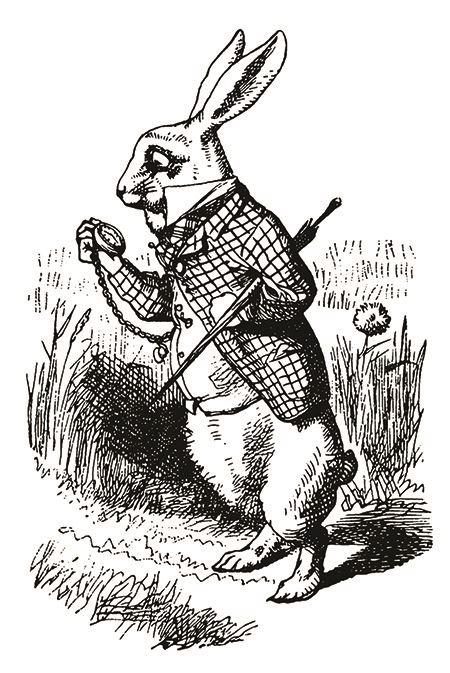
John Tenniel’s 1865 illustration of the White Rabbit from the original book Alice’s Adventures in Wonderland
The White Rabbit in Alice’s Adventures in Wonderland is the first character that Alice encounters. He is formally dressed and is nervously singing,
| I’m late
I’m late For a very important date. No time to say “Hello, Goodbye.” I’m late, I’m late, I’m late. |
Alice is curious as to what the White Rabbit is up to, so she follows him and falls down the rabbit hole, thereby discovering Wonderland. “Falling down the rabbit hole” has become a metaphor for inadvertently entering a strange and challenging situation.
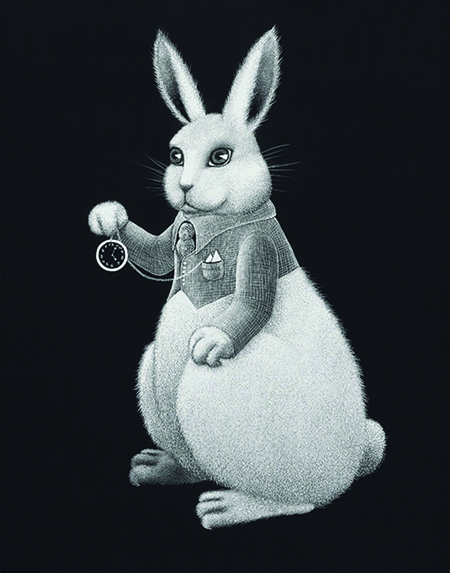
White Rabbit, painted by Grace Slick, hangs in my home next to Terry Guyer’s painting of Alice Liddell
Alice Liddell’s father Dean Liddell appears to have been the inspiration for the White Rabbit as he had a reputation for always being late and in a hurry.
Alice encounters the White Rabbit again later in the story and he mistakes her for his housemaid Mary Ann. He orders her to fetch his gloves and a fan. She enters his house and, as often happens in Wonderland, she grows in size and thereby gets stuck.
Finally, we discover that the White Rabbit is also a herald in the court of the Queen of Hearts, the villain of the story.
“White Rabbit,” based on the character in Alice’s Adventures in Wonderland, is the most famous song of the 1960s rock band, Jefferson Airplane. It was written by their lead singer Grace Slick. I sang Slick’s “White Rabbit” at the 2001 TED conference having turned myself into a young female rock singer (named Ramona) using virtual reality technology. See the entry for pitch modification for more details on this performance and how the technology worked.
![]()
In the alternative reality of Danielle: Chronicles of a Superheroine, two-year-old Danielle explains why she does not like the White Rabbit.
7. Queen of Hearts
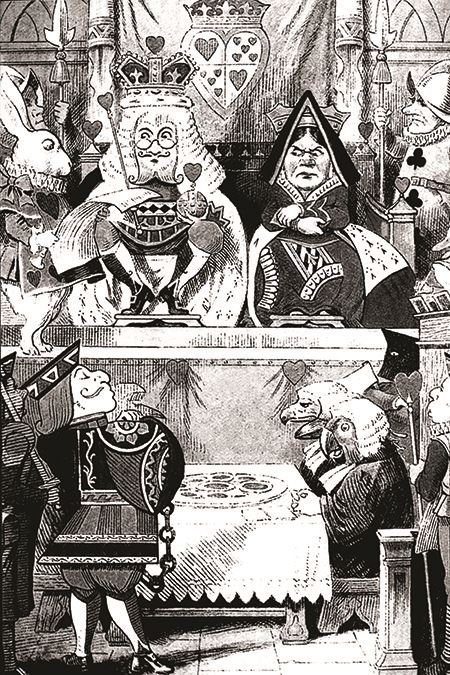
John Tenniel’s 1865 illustration of the King and Queen of Hearts from the original book Alice’s Adventures in Wonderland
Late in Alice’s Adventures in Wonderland, Alice encounters talking playing cards, which we can consider to be an early allusion to technology that talks. One of the cards is the Queen of Hearts (not to be confused with the Red Queen in Lewis Carroll’s other classic book Through the Looking Glass). The Queen of Hearts is infamous for saying “Off with his head.”
She warns Alice herself: “I warn you, child … if I lose my temper, you lose your head! Understand?”
Carroll saves his novel from undue violence by having the Queen of Hearts’ more sympathetic husband, the King of Hearts, pardon the intended victims of her decrees when she is not looking. In one case, when the Queen orders the beheading of the Duchess, the King does not get around to pardoning her, but the soldiers nonetheless refrain from carrying out the order and humor the Queen instead.
The Queen explains her approach to Alice by saying “sentence before verdict.” Although everyone in Wonderland seems to fear the Queen, a character named the Gryphon explains to Alice, “It’s all her fancy: she never executes nobody, you know.”
Some commentators have written that the Queen of Hearts may be a caricature of Queen Victoria. Carroll apparently provided details that would be recognizable to adults at the time but not recognizable to children.
![]()
In the alternative reality of Danielle: Chronicles of a Superheroine, two-year-old Danielle observes that the White Rabbit is fake-nice to the Queen of Hearts.
8. Onomatopoeia
Onomatopoeia refers to a word whose sound imitates what the word refers to. It may also simply suggest the feeling of the word. Animal sounds are often good examples, such as meow, oink, roar, and croak.
The word appears to come from the Greek language word, ὀνοματοποιία which means “making or creating names.”
Onomatopoeia has been extensively used in comics to illustrate the action, for example, words such as “bam,” and “pow.” Roy Lichtenstein made the word “Wham!” famous in his early pop art, which was inspired by comics.
![]()
In the alternative reality of Danielle: Chronicles of a Superheroine, in her first words at age two, Danielle makes the point that the word “onomatopoeia” is odd in that it is itself not an example of onomatopoeia.
9. Martine Rothblatt
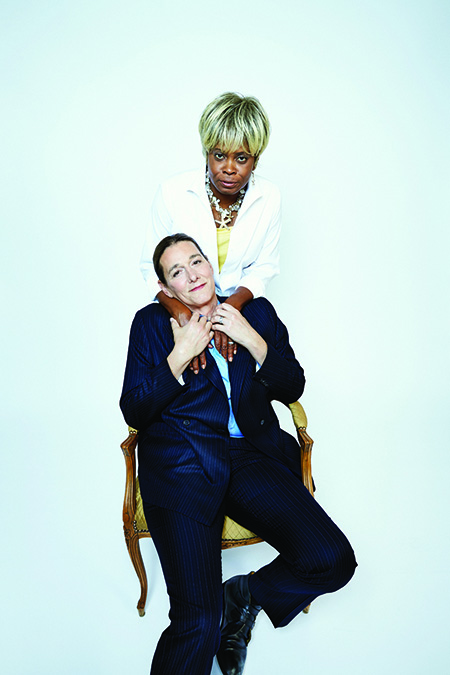
Martine Rothblatt and her wife Bina Aspen, photo for New York magazine September 2014
Martine Rothblatt (born 1954) is an American lawyer and entrepreneur in diverse fields including telecommunications, aviation, medicine, and futurism. She is also widely renowned as the world’s most successful transgender CEO (and in 2015 was the highest paid female executive in the United States), and the author of a bestselling 1995 book on gender issues called The Apartheid of Sex.
My friend Martine was born Martin Rothblatt to a Jewish family in Chicago, and studied satellite communications at UCLA before going on to work as a regulatory attorney, arguing before the Federal Communications Commission on behalf of telecom companies. This experience gave Rothblatt an understanding of the potential for satellite technology to disrupt the broadcasting industry. And so, Rothblatt became involved in several successful satellite startups, including PanAmSat in 1984, which provided satellite television to Latin America.
In 1986, Rothblatt became cofounder and CEO of GeoStar, a revolutionary satellite navigation system that commercialized GPS and made it useful to the public. Rothblatt’s next major venture was Sirius Satellite Radio in 1990. It took twelve years of research, testing, and lobbying to make Sirius a reality, but it made a huge impact on the broadcasting industry when it went live in 2002.
In the early 1990s, Martin Rothblatt came to the realization that although born with a male body, his most authentic self was female. And so, in 1994 he came out as a woman and completed gender reassignment surgery. Bina Aspen, Martin’s wife, told him that she loved Martin for his soul not his skin, and supported the transition process. Martin became Martine, but reassured her children that she would remain their father.
The following year, Rothblatt authored a book called The Apartheid of Sex, which argues that the rigid differences between male and female are largely a social construct. Instead, Rothblatt encourages readers to see gender as existing as rich varieties of experience along a spectrum. She says that there are as many ways of expressing gender as there are people in the world. The book had a major impact on the debate about transgender rights and the nature of gender itself. It was particularly groundbreaking for the public to see that a prominent transgender activist was so successful in other areas of life, and did not define herself primarily by that one aspect of her identity.
Around the time of Martine’s transition, her family was experiencing a much greater challenge. Her youngest daughter Jenesis had been diagnosed with Pulmonary Arterial Hypertension (PAH), a degenerative disease of the blood vessels between the lungs and heart. Doctors told the Rothblatts that it was always fatal, and that the life expectancy of a young child diagnosed with the disease was years at best. There was no cure, and the only medicine that could even slow the progression of the disease required constant intravenous delivery, at very high cost. Glaxo, the pharmaceutical company that made this drug, had a patent for a much better alternative treatment, but was not using it.
Rothblatt learned that because PAH is such a rare condition, pharmaceutical companies considered it an “orphan disease,” which means that not enough people would need a PAH drug to justify spending all the money needed to bring it to market. But seeing her child’s suffering, Rothblatt wouldn’t take no for an answer. She convinced Glaxo to license the patent to her cheaply, and then recruited a network of pharmaceutical experts to develop it into a usable medicine. To accomplish this, in 1996 she founded a biotechnology company called United Therapeutics, of which I have been a board member since 1999. After much persistence, United Therapeutics succeeded in bringing its PAH drug to market, and now conducts research into methods of treating and curing other diseases, including other orphan diseases and cancer.
Because people with PAH often require lung transplants, in 2011 Rothblatt established a United Therapeutics division called Revivicor, dedicated to mastering the science of “xenotransplantation.” This is the process of transplanting tissues or organs from one species into another. Rothblatt says this is desirable because far more people need organs than there are humans to donate them. The waiting list for human organs gets longer every year, with only about a quarter of people on the list receiving one.
Yet when an animal organ is transplanted into a human, the animal’s genetic differences cause the organ to be inevitably damaged and rejected. Revivicor’s research aims to genetically modify animal organs to make them essentially human organs (and ultimately with the patient’s own DNA) so they will be accepted. If this works, Rothblatt says, humans will gain “an unlimited supply of transplantable organs.” Revivicor focuses on growing pig tissues, and is already working with transplanting them into primates—for example, transplanting pig hearts, lungs, and kidneys into baboons, and pancreatic islet cells into monkeys to cure their diabetes. Rothblatt intends to begin human testing later this decade.
Flying may seem like a much different field from biotechnology, but is actually relevant because of the need to quickly deliver organs for transplant. And so, Rothblatt is an accomplished pilot, including helicopters. In 2016, she worked with the Tier 1 Engineering company to design and build the world’s first full-size electric-powered helicopter. Inspired by the success of Tesla at developing high-performance electric cars, Rothblatt understood that battery technology is the key. The project defied expectations and had a successful test flight, paving the way for more and better electric helicopters in the future, which can hopefully be used to make the transfers of organs and other vital medical treatments easier.
Despite all these accomplishments, Rothblatt hopes that her greatest impact will come in the area of transhumanism. Transhumanism is a school of thought (which I share) based on the idea that our species can use technology to transcend the limitations of biology, like disease, aging, and death. In 2002, Martine and Bina founded the Terasem Movement, which is part “transreligion” and part scientific foundation, to support a transhumanist vision of the future.
Terasem has four core beliefs:
| I. Life is purposeful
II. Death is optional III. God is technological IV. Love is essential |
While many religions believe in a supernatural afterlife, Terasem teaches that “we can live joyfully forever if we build mindfiles for ourselves.” Mindfiles are collections of information about someone’s memories, feelings, beliefs, and personality. Terasem believes that it will one day be possible to create “cyberconsciousness” by transferring a human being’s consciousness from their biological brain to the digital realm. This would require a combination of advanced computers and the information in mindfiles. This could protect a person’s identity from the disease and damage that human brains are vulnerable to. According to Terasem, this will be a kind of immortality. Although such technology is not yet possible, my Law of Accelerating Returns suggests that within two to three decades, computing power and artificial intelligence software will be powerful enough to enable people to record all their thoughts, memories, and skills, and to bring them to life in a digital substrate. Rothblatt was the executive producer and, through Terasem, the primary funder of a movie that I made titled The Singularity is Near, that presents this vision of the future
As a sort of inspirational prototype for Terasem’s vision of transferring human consciousness and identity into a nonbiological form, Rothblatt worked with Hanson Robotics to create a humanoid robot called Bina48. It is based on her wife, Bina Aspen, and has a face and voice designed to match those of the original person. Martine has uploaded large amounts of data about Bina, from memories and beliefs to her mannerisms and personality. Combined with today’s artificial intelligence, this provides a very basic approximation of what cyberconsciousness will be when technology is advanced enough. Bina48 can converse with humans in natural language, and one of her conversations with the “real” Bina went viral on YouTube.
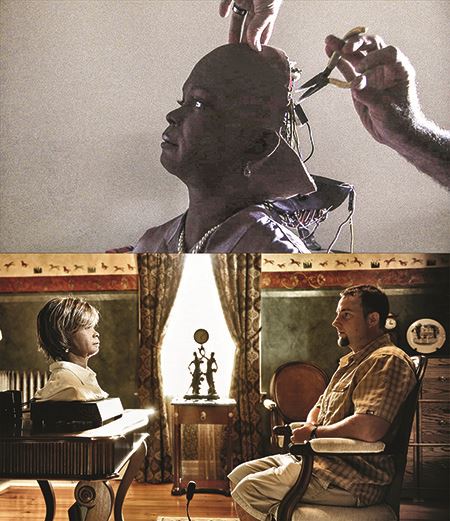
Bina48 appears like a human from the outside, but is a robot on the inside
![]()
In the alternative reality of Danielle: Chronicles of a Superheroine, when Danielle’s dad opens a school based on the idea of “learn from doing,” he has a groundbreaking ceremony with people who contributed money for it.
At the ceremony, Danielle, aged two, introduces herself to Martine Rothblatt. She shows Rothblatt the model computer she has built out of flowers based on the design of the Analytical Engine designed by Charles Babbage in 1837, and they talk about Ada Lovelace, daughter of the poet Lord Byron, who wrote programs for the Analytical Engine and thereby the world’s first computer programmer.
Later, Rothblatt helps Danielle when Columbus Records sues the eight-year-old Danielle over her creation of Danielle Music. Danielle negotiates aggressively with Rothblatt over how much of a stake Danielle Music Rothblatt’s $30 million Series A investment should be worth. When Danielle talks down Rothblatt’s share from 30 percent to 12 percent, Rothblatt compliments her negotiating skill, and agrees that Danielle will make an excellent CEO for Danielle Music. As Danielle grows up, Rothblatt continues to act as a mentor and advisor on projects such as Danielle Stem Cell.
Then, when Danielle says that she would accept a Grammy nomination for Best Male Singer, this causes an uproar among people who object to a teenage girl competing in a male category. Danielle asks her sister Claire to explain Danielle’s motivation to the public. Claire asks Variety magazine: “Why shouldn’t gals be allowed to compete for this category or any category?” and tells readers that males are welcome to compete for Best Female Singer. Danielle addresses the controversy by tweeting that people should read Martine Rothblatt’s The Apartheid of Sex.
See entries for Ada Lovelace, Music Streaming, Incentive Stock Options, Black Scholes Valuation, Chief Operating Officer, Series A Investment, Simple Preferred Stock, Ratchet Downside Protection, Nonstatutory Stock Options, The Apartheid of Sex, Artificial Intelligence, Neocortex, Plasticity of the neocortex, Fruit of Knowledge, Microbot swarm, and Drug cocktail.
How You Can Be a Danielle and encourage women and girls to pursue STEM careers.
How You Can Be a Danielle and promote racial and gender equality.
10. Analytical Engine
The Analytical Engine was a mechanical computer designed by the English mathematician Charles Babbage (1791–1871) in 1837. Had it actually worked, it would have been the world’s first general purpose programmable computer. Despite never running, the design had all the elements of a programmable computer and established the fundamental architecture for a modern computer. Indeed, virtually all computers in use today are based on Babbage’s nineteenth century design. It included the basic elements of computation, including an arithmetic logic unit, a stored program, and logical control through the use of conditional branch instructions and loops. The memory store had 1,000 positions of 40 decimal digits each.
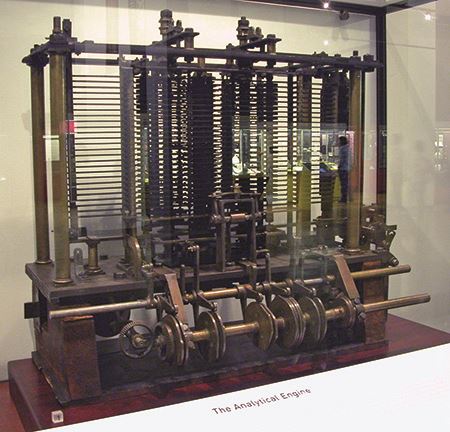
A portion of the Analytical Engine constructed by Charles Babbage
Babbage ran out of funds and the computer was never completed. Portions of it were built and scholars have debated whether the computer would have been feasible given the state of mechanical technology in the mid-1800s. As it was, it would be another century until the first general-purpose, programmable computers were built during World War II.
![]()
In the alternative reality of Danielle: Chronicles of a Superheroine, the two-year-old Danielle plants a flower garden in which the flowers represent bit positions in the central processing unit of Babbage’s Analytical Engine. Danielle represents the memory store with rows of 40 flowers each. She shows her garden to Martine Rothblatt who is impressed.
See the entry for Ada Lovelace.
11. Ada Lovelace
Ada Lovelace (1815–1852), a collaborator with Charles Babbage, is known as the world’s first computer programmer.

A watercolor portrait of Ada Lovelace by Alfred Edward Chalon
She was the only legitimate child of the poet Lord Byron.
She was educated as a mathematician and worked with Babbage on his Analytical Engine, the world’s first general purpose, programmable computer, although it never ran. In 1842, she translated an article by the Italian engineer Luigi Menabrea and added an extensive section of her own, simply called “Notes.” In this section, she includes what is regarded as the world’s first computer program which was intended to be run on the Analytical Engine. It is a program to compute a mathematical function called “Bernoulli numbers.
Here is her program, the first computer program ever written:
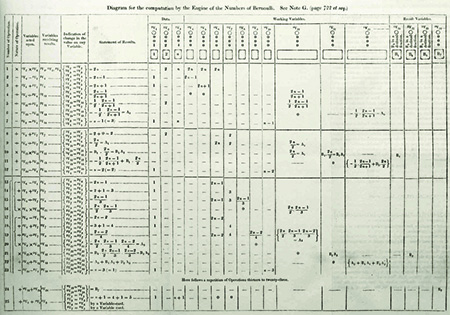
Diagram of an algorithm for the Analytical Engine for the computation of Bernoulli numbers from Sketch of the Analytical Engine Invented by Charles Babbage by Luigi Menabrea, with notes by Ada Lovelace (1842)
In her “Notes,” Lovelace speculates on the feasibility of artificial intelligence, the first such speculation ever written. Around the same time, she wrote in a letter to her mother that she was working on “certain productions” investigating the relationship between music and mathematics. While she writes about the similarity of computation to thinking, she concludes in her “Notes” that “The Analytical Engine has no pretensions whatever to originate anything. It can do whatever we know how to order it to perform.” She also concludes that in the future, computers such as the Analytical Engine will collaborate with individuals and society.
![]()
In the alternative reality of Danielle: Chronicles of a Superheroine, Martine Rothblatt and the two-year-old Danielle discuss why Ada Lovelace is admirable.
See the entry for Analytical Engine.
How You Can Be a Danielle and learn to program computers at a young age.
12. The Stern Schule
Regina Stern, my mother’s mother’s mother, and her family (the Stern family) started a school (the Stern Schule) in Vienna in 1868. This school was the first school in Europe to provide higher education (up through “gymnasium,” which is equivalent to the first two years of college) for girls. The school became influential throughout Europe on the issue of education for women. It was controversial, as many observers did not see the point of educating girls beyond ninth grade. It was run by my great-grandmother and then taken over by her daughter, my grandmother, Lillian Bader, who became the first woman in Europe to be awarded a PhD in chemistry.
In March of 1938, Hitler came into Austria and annexed it in what has become known as the “Anschluss” (annexation). As Hitler entered Vienna, he went directly to the Heldenplatz (Plaza of Heroes) and gave a trademark vitriolic (and anti-Semitic) speech which has become infamous.
The huge Heldenplatz was completely filled with greatly enthusiastic Austrians shouting “Sieg Heil!” (Hail victory!) in response to Hitler, and wildly waving flags with swastikas. Photos and television coverage spread quickly, and the world began to learn the true nature of the Hitler phenomenon.

News photo of Hitler speaking to Austrians in the Heldenplatz in March of 1938
My grandparents decided they would need to leave Vienna and began to make preparations. My grandmother finished the school’s 1938 spring semester, celebrated the 70th anniversary of the school and fled with my grandfather and their two daughters (my mother and my Aunt Dorit), abandoning the school (and all other possessions). There were many harrowing stories behind this escape during the summer of 1938 including the arrest of my grandfather and his daughter’s (my aunt’s) successful effort to get him freed. They got out of Austria just in time, because November 1938 brought “Kristallnacht,” when all of the Jewish synagogues were destroyed, and it became virtually impossible for Jews to escape Austria.
![]()
In the alternative reality of Danielle: Chronicles of a Superheroine, the Stern Schule is the inspiration for Danielle’s dad to found the Stern School, which becomes Danielle’s school.
How You Can Be a Danielle and foster learn by doing.
